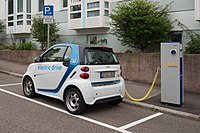| Type | Electric vehicle, motorcycle, construction machine, aircraft and ship charging | ||
|---|---|---|---|
| Production history | |||
| Designer | CHAdeMO Association, China Electricity Council (CEC) | ||
| Designed | 2018‒2020 | ||
| Produced | 2021‒ | ||
| General specifications | |||
| Pins | 7 (1 earth, 1 positive, 1 negative, 4 signalling for standard configuration) [1] | ||
| Connector |
| ||
| Electrical | |||
| Signal | DC | ||
| Earth | Dedicated pin | ||
| Max. voltage | 1500 V | ||
| Max. current | 600 A | ||
| Pinout | |||
 | |||
| Pinouts for ChaoJi vehicle connector and vehicle inlet | |||
| DC+ | Positive | power | |
| DC- | Negative | power | |
| PE | Protective earth | full-current protective earthing | |
| CC1 | Connection Confirmation 1 | charger ⇄ car | |
| CC2 | Connection Confirmation 2 | car ⇄ charger | |
| S+ | Signalling |
CAN_H | |
| S- | Signalling |
CAN_L | |
| 2×10-millimetre-diameter (0.4 in) power transfer pins [2] | |||
The ChaoJi connector, also referenced as CHAdeMO 3.0, is an ultra-high-power charging standard charging electric cars, released in 2020. [3] The connector has a lemniscate shape ( ∞), with a flat bottom edge and is planned for charging battery electric vehicles at up to 900 kilowatts using direct current. The design incorporates backward compatibility with CHAdeMO (used globally) and the GB/T DC-charging (used mainly in mainland China), [4] using a dedicated inlet adapter for each system. The circuit interface of ChaoJi is also designed to be fully compatible with the Combined Charging System, also known as CCS (used mainly in Europe and North America). [5]
A joint agreement between the CHAdeMO association and the China Electricity Council (with State Grid Corporation of China) was signed on 28 August 2018 [6] after which the development was enlarged to a larger international community of experts. [7]
Implementation
The new EVs implementing the standard are to be fitted with a female ChaoJi DC inlet, with a vehicle-side locking mechanism. This inlet can be co-sited in a "Combo" format underneath a GB/T-AC inlet (female), an SAE J1772 AC inlet (male), or 1‒3-phase AC Type 2 inlet (male). [8]
For the charging infrastructure, DC fast-chargers would be fitted with the common ChaoJi male plug outlet and implement one or more variations of communication protocols: [8]
- ChaoJi-1 operating under the GB/T protocol, for primary deployment in mainland China.
- ChaoJi-2 operating under the CHAdeMO 3.0 protocol, for primary deployment in Japan and other parts of the world.
Communication between the car and charger would use a CAN bus for both ChaoJi-1 and -2. [8] A unified communication protocol based on Ethernet is also under consideration. [9]
Power transfer pins are 10-millimetre-diameter (0.4 in) and attached to the infrastructure (male) side. [2] The connector is designed to be at least as strong as a CHAdeMO outlet. [1]
Updates to the ChaoJi standard enables compatibility with the CHAdeMO 3.1 protocol (and by extension CCS). [10]
Megawatt charging

A new coupler codenamed ‘Ultra-ChaoJi’ with an additional set of power pins above the standard ChaoJi pinouts, is currently under development. Ultra-ChaoJi is expected to be used by electrified heavy-duty vehicles (HDVs), airplanes and ships in the near future.
Etymology
The name comes from 超级, meaning "super". The reason for choosing such a name was multifactorial. Other than the reference to supercharging, the word ChaoJi itself sounds similar to "charger" and, like CHAdeMO, starts with "Cha".
References
- ^
a
b Imazu, Tomoya; Yoshida, Dave Makoto; Blech, Tomoko.
CHAdeMO 3.0 – Standard harmonization efforts between CHAdeMO and GB/T (PDF). eMOVE360 2019 Charging & Energy Conference. pp. 12‒14, 16.
Interoperability/backward compatibility … CHAdeMO and ChaoJi to co-exist as multi-outlet chargers … Mechanical strength of the connector equivalent to CHAdeMO, to avoid breakage in the field. … Safety specification identical or better than CHAdeMO. … Control-pilot circuit harmonized with new GB/T and CCS (and IEC 61851-23-1) … Backward compatibility with CHAdeMO, GB/T and (potentially) CCS. … Optional combo-style inlet integrating AC type-1, -2 and GB/T-AC
- ^
a
b Yoshida, Dave Makoto; Tsuchiya, Katsunori (2020-02-17).
"Charging Standard: Future Direction" (PDF). Charging Infrastructure for Vehicles Using Battery Storage: Perspective on Standardisation Developments.
International Transport Forum: 28. Retrieved 2020-03-23.
10 mm
- ^ Berman, Bradley. "CHAdeMO 3.0 to harmonize global EV quick charging standards". www.sae.org. Retrieved 25 February 2023.
-
^ Nisewanger, Jeff (2019-06-19).
"Joint China and Japan ChaoJi project works towards "CHAdeMO 3.0"". Electric Revs.
common connector design called ChaoJi for future use in Japan, China, … ChaoJi (超级) means "super" in Chinese. … new common plug and vehicle inlet that can support up to 600A at up to 1,500V for a total power of 900 kW.
- ^ NI Feng, IMAZU Tomoya (2020-06-19). "ChaoJi: A Unified Future-Oriented Charging Programme" (PDF). CHAdeMO Association. Archived (PDF) from the original on 2020-09-20. Retrieved 2021-09-07.
-
^ Yoshida, Makoto; Tsuchiya, Katsunori (2018-11-30).
Super High Power Charging: China-Japan Joint Research Project (presentation) (Report). p. 16. Retrieved 2020-03-23.
China and Japan Agreement … Agreement to develop common new standard on … China Electricity Council and CHAdeMO Association Agreed to Establish the new future Standard for 2020
- ^ Blech, Tomoko (11 September 2020). Project ChaoJi: the background and challenges of harmonising DC charging standards. 33rd World Electric Vehicle Symposium & Exposition (EVS33). doi: 10.5281/zenodo.4023281. Archived from the original on 2020-09-18. Retrieved 10 December 2020.
- ^
a
b
c Blech, Tomoko Yamabe (2019-04-16).
HPC: challenges and potential solutions (PDF). CHAdeMO DC charging standard: evolution strategy and new challenges (Report). Stuttgart. p. 16,20,21.
Control-pilot circuit harmonised with new GB/T and CCS (and IEC 61851-23-1) … Backward compatibility with CHAdeMO, GB/T and (potentially) CCS … Optional combo-style inlet integrating AC type-1, -2 and GB/T-AC … New ChaoJi EVs will be able to charge with the existing CHAdeMO and GB/T chargers using an 'inlet adapter'. Existing CHAdeMO and GB/T EVs are not allowed to use any adapters, so they will need to use the dual chargers during the transition period. Backward compatibility with CCS is also technically possible, detailed specification is under consideration. Note: the amendment of IEC 61851-1 is necessary for the use of adapter
- ^ NI Feng / IMAZU Tomoya (2020-06-19). "Chaoji: A Unified Future-Oriented Charging Programme" (PDF). Archived (PDF) from the original on 2020-09-20. Retrieved 2020-09-07.
- ^ https://www.greencarreports.com/news/1140871_china-updates-its-ev-charging-standard-claims-cross-compatibility
Further reading
- Berman, Bradley (2020-05-28).
"New CHAdeMO 3.0 aims to harmonize global EV quick-charging standards". Automotive Engineering.
SAE International. Retrieved 2020-06-06.
co-developed by the China Electricity Council … 900 kW of power – with a peak of 600 amps and 1,500 volts … Adaptors will likely be produced and sold for Tesla and CCS-compatible vehicles to use CHAdeMO 3.0 chargers … new coupler reduced the number of pins from seven to four, removing the optional … 12-volt auxiliary power to bi-directional chargers. … Under the ChaoJi design, CHAdeMO and China's GB/T chargers use the same hardware. … control-pilot circuit detects which of the two communications protocols to use

